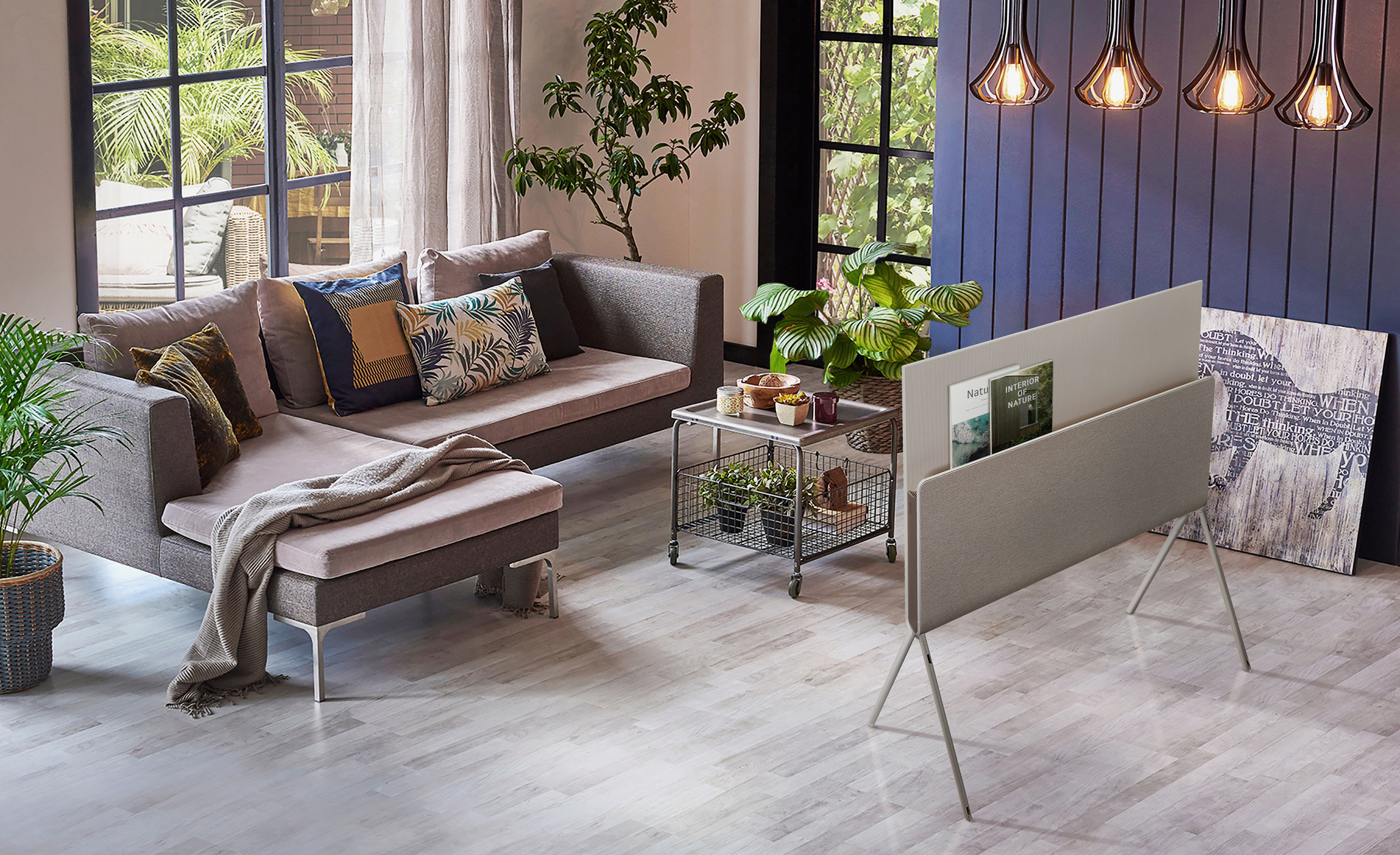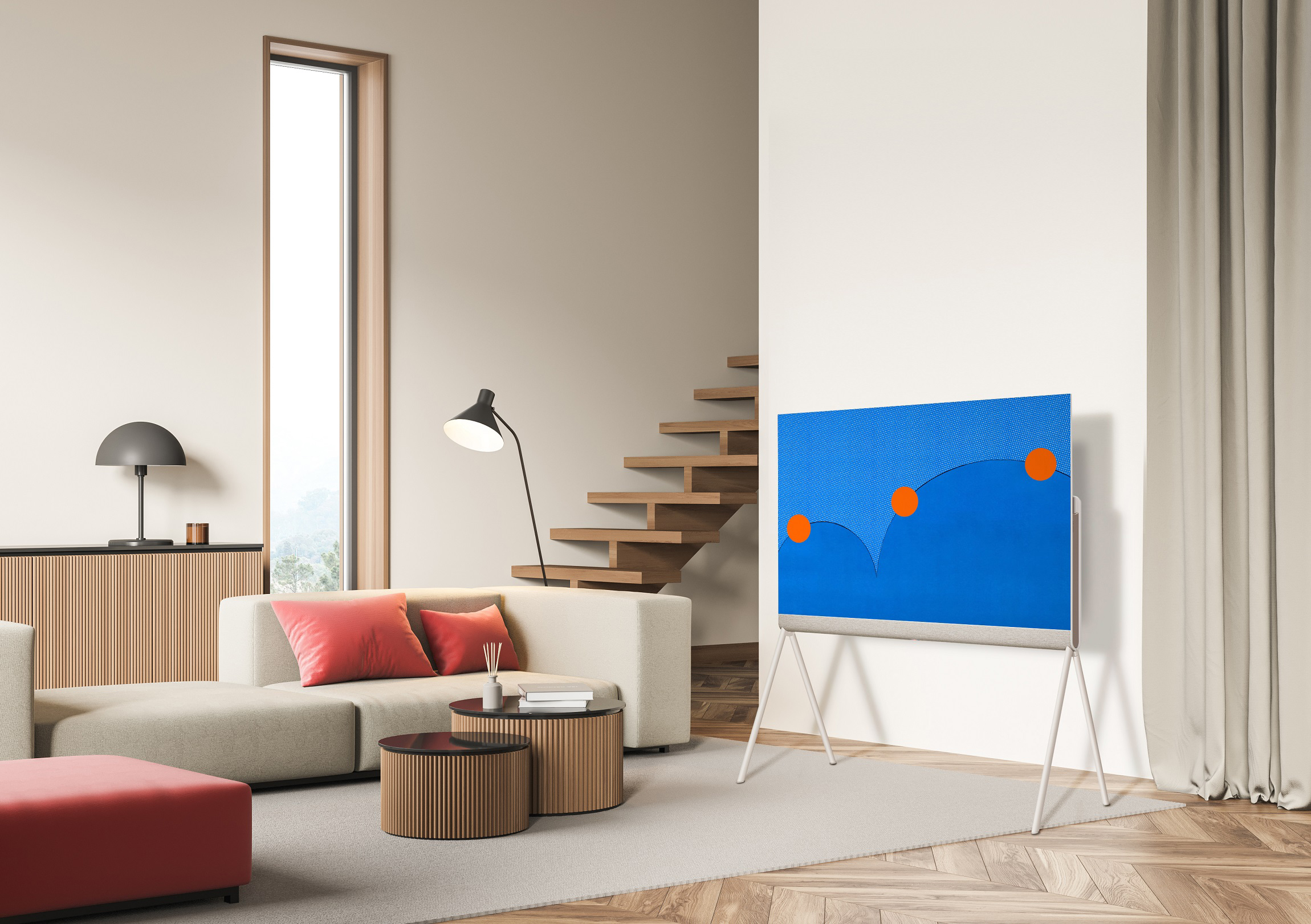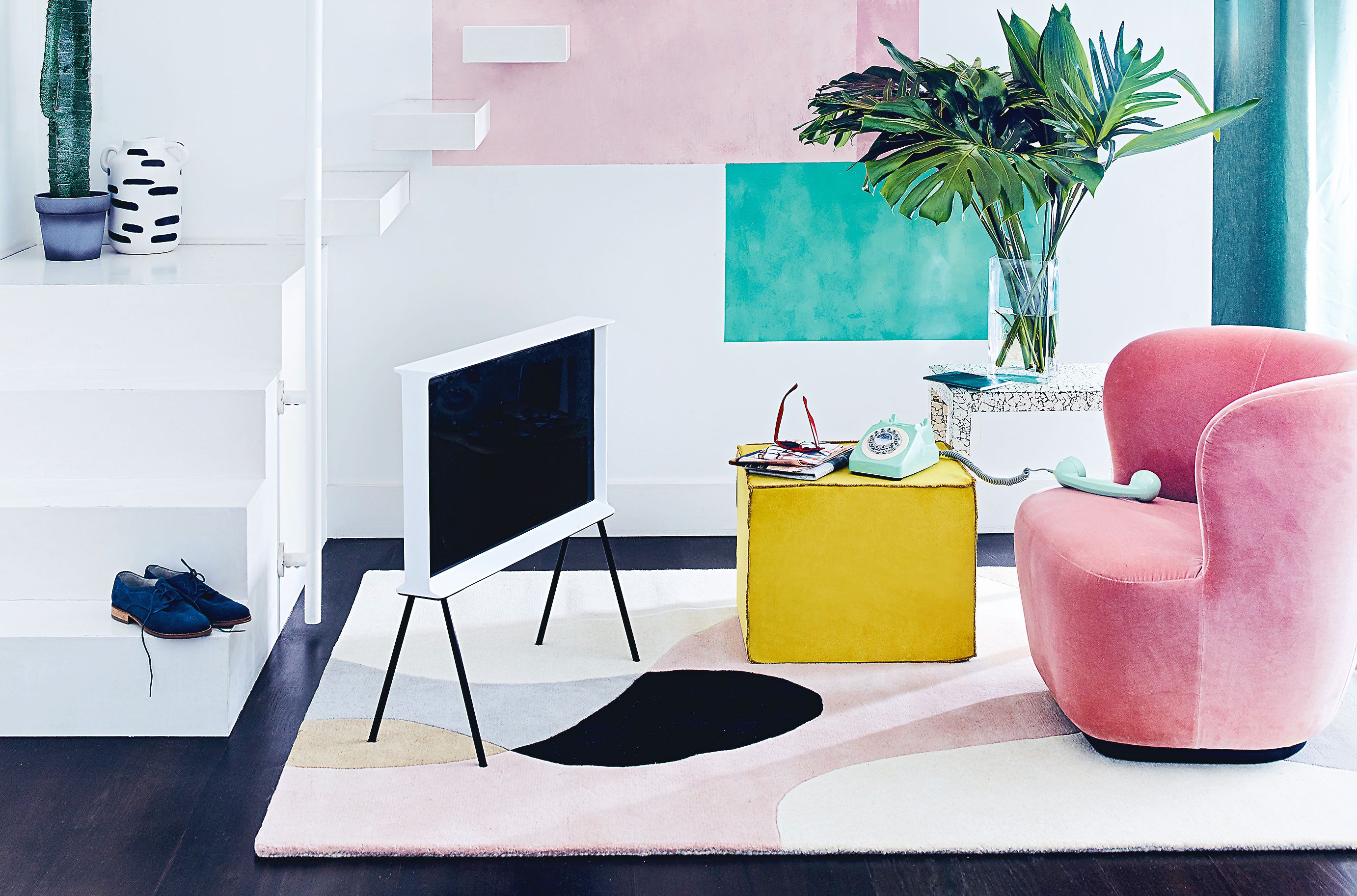This designer TV trend is about to redefine how you lay out your living room, say experts
With impossibly chic new releases on the horizon, the freestanding TV trend is about to free up your home to new, more exciting layouts. Here's what you need to know about it


Living room design is best when it's free from the shackles of arranging your furniture around a TV, and though you can take steps to minimize your small screen's impact on a space, it's the layout where you're beholden to creating a good view, if you're a regular TV watcher.
However, there's an interior design trend for televisions resurfacing which, while not brand new, might be about to take on new relevance in our homes.
Fresh from the interiors taste-making event in Milan, Salone del Mobile, one of the best TV brands LG unveiled two new freestanding television designs in collaboration with Dutch design brand Moooi - the tech brand now truly dipping its toes in the field of designer TVs. Named Posé and Easel, the two models fulfill different needs, but both have a considered design that would make you want to show your TV off, not hide it away.
Freestanding models aren't unheard of, but they are a rarer find. Most belong to high-end, high-price tag tech brands like Bang & Olufsen and Loewe, though there are some more mid-range options, such as Samsung's The Serif, designed by the Bouroullecs.
But, if the idea of a freestanding TV is such a good one, why hasn't it taken off yet in a more meaningful way? And could these new designs be the real dawn of the freestanding TV in our homes?
Are freestanding styles really the next big TV trend?

LG's Posé resembles a piece of furniture or art object, more than a traditional TV.
You might not think of TV trends in the same way as you would interiors trends, but there's undoubtedly an undercurrent of aesthetics that informs how modern TVs are designed.
'Ever since TVs went flatscreen, companies have been racing to make them as minimalist as possible – pushing them to be thinner and with the smallest-possible bezel,' says Matthew Bolton, a senior editor for TV and audio at TechRadar. 'New screen technologies such as OLED and mini-LED have helped make this possible, but we're only going to be able to go so thin, and then what?'
Be The First To Know
The Livingetc newsletters are your inside source for what’s shaping interiors now - and what’s next. Discover trend forecasts, smart style ideas, and curated shopping inspiration that brings design to life. Subscribe today and stay ahead of the curve.
'When you look at some TV designs today, they feel almost apologetic about the fact that they have to take up space in your living room, and I don't think that needs to be the case.'
It's true that in many of even the most well-designed spaces huge compromises are made for the sake of ideas for hiding a TV. These include vast built-ins, clever millwork systems or even paint color ideas that allow the TV to blend into the background.
'Samsung's The Frame TVs have been a huge hit with people who love interior design by actually leaning into the fact they're physical objects – Samsung gave these TVs a thicker bezel to emphasize their shape so that they appear reminiscent of picture frames,' Matt explains. 'We're all already used to the shape of a picture frame on our walls, so The Frame TV leaned into this, borrowing the look of another object to help it fit in, rather than trying to pretend it didn't exist at all.'
Freestanding TVs are a little different in that they're not trying to disguise themselves as anything else, rather elevate the idea of TV design as something that doesn't need to be hidden away.
'With some of the freestanding TVs that are appearing today, we're finally seeing TVs start to own their physicality,' Matt adds. 'The LG Posé is designed to be seen from every angle, and takes its design cues from mid-century furniture, for example.'
But with freestanding TVs already on the market, there's a reason why this living room TV idea hasn't been adopted on a wider scale. 'Most of these designs are currently based around high-end TVs, with a further premium added for the extra design touches, which will limit their appeal,' Matt says. 'The reason Samsung's The Frame TVs are such a hit is that they're based on more mid-range technology, so I think the next thing to watch out for will be which TV company cracks creating a freestanding TV that balances both aesthetic appeal and price.'
The likes of the Samsung's The Serif is available at a lower price point, but though originally introduced in 2016, it was done so as a limited edition, which has only just seen greater availability in the last few years after re-launching.
What makes a freestanding TV a good idea?

There's something to having the opportunity to avoid needing a media unit in your home, which can feel bulky. 'I like my living spaces to be as airy as possible - elegant legs on sofas and coffee tables help increase the feeling of space as light flows between them,' explains Livingetc's editor Pip Rich, who chose Samsung's The Serif for his own living room. 'A freestanding TV with slimline legs continues this sense all the way into the corner of the living room, helping to stop the television from seeming like it dominates the room too much.'
The freestanding nature can also help make for more dynamic living room layouts. Designer, stylist and Livingetc.com contributor Luke Arthur Wells, who also has Samsung's The Serif, found it the best solution for fitting a TV across a series of narrow alcoves in his home for a small living room layout.
'The problem with my space came in that a traditional TV and media unit set-up was top-heavy, as only a small unit would fit into an alcove,' he explains. 'Not only does the freestanding TV look better, but it meant I could move it to a different area in the living room, without it eating up too much space and affecting the room's circulation.'
In LG's imagery for its new Posé model, the brand showcases the freestanding TV in the center of open-plan rooms, looking great from every angle. Of course, these TVs still require a power supply and have cables, though much more discreet than traditional TVs.
For this idea to work, then, you'd need to consider floor-mounted sockets in your living room, hidden in the floor in the right space. It's a big ask for a casual TV watcher, but if you have your heart set on elevating your space's design with one of the latest designer TVs, it might be a job to plan into your home's remodel.

Hugh is Livingetc.com’s editor. With 8 years in the interiors industry under his belt, he has the nose for what people want to know about re-decorating their homes. He prides himself as an expert trend forecaster, visiting design fairs, showrooms and keeping an eye out for emerging designers to hone his eye. He joined Livingetc back in 2022 as a content editor, as a long-time reader of the print magazine, before becoming its online editor. Hugh has previously spent time as an editor for a kitchen and bathroom magazine, and has written for “hands-on” home brands such as Homebuilding & Renovating and Grand Designs magazine, so his knowledge of what it takes to create a home goes beyond the surface, too. Though not a trained interior designer, Hugh has cut his design teeth by managing several major interior design projects to date, each for private clients. He's also a keen DIYer — he's done everything from laying his own patio and building an integrated cooker hood from scratch, to undertaking plenty of creative IKEA hacks to help achieve the luxurious look he loves in design, when his budget doesn't always stretch that far.
-
 My 10 Favorite Designs at Milan Design Week 2025 — Out of the Hundreds of Pieces I Saw
My 10 Favorite Designs at Milan Design Week 2025 — Out of the Hundreds of Pieces I SawThere is a new elegance, color, and shape being shown in Milan this week, and these are the pieces that caught my eye
By Pip Rich
-
 Iridescence Is Chrome’s More Playful, Hard-to-Define Cousin — And You're About to See It Everywhere
Iridescence Is Chrome’s More Playful, Hard-to-Define Cousin — And You're About to See It EverywhereThis kinetic finish signals a broader shift toward surfaces that move, shimmer, and surprise. Here's where to find it now
By Julia Demer